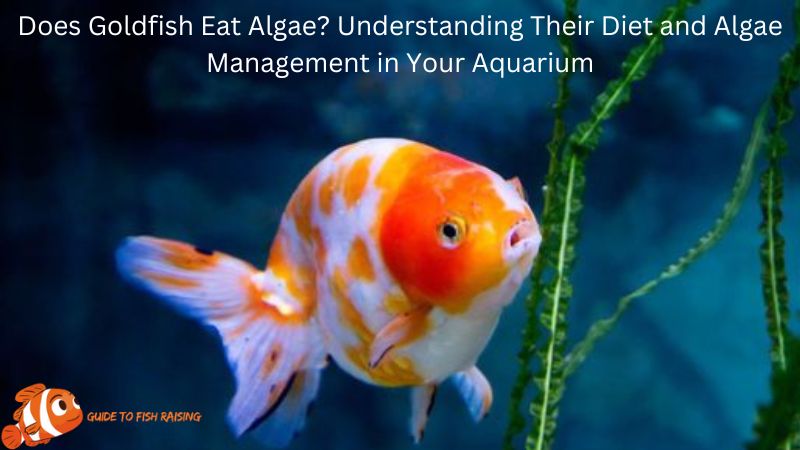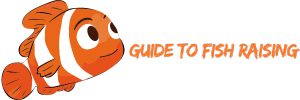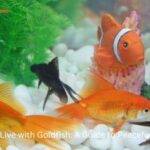Does Goldfish Eat Algae? Goldfish are one of the most popular and beloved aquarium fish. Known for their vibrant colors and easy-going nature, they are often a staple in home aquariums. One common question that goldfish owners have is whether goldfish eat algae. This article Guide to Fish Raising will explore goldfish dietary habits, their relationship with algae, the benefits and drawbacks of algae in an aquarium, and how to manage algae growth effectively.
Table of contents
ToggleUnderstanding Goldfish Dietary Habits
Natural Diet of Goldfish
Goldfish are omnivores, meaning they eat both plant and animal matter. In their natural habitats, goldfish consume a variety of foods, including:
- Insects and larvae: These are a primary protein source for wild goldfish.
- Crustaceans and zooplankton: Small aquatic animals and microorganisms form part of their diet.
- Plants and algae: Goldfish graze on aquatic plants and algae, which provide essential nutrients.
- Detritus: Decomposing organic matter is also consumed by goldfish.
Goldfish in Captivity
In home aquariums, goldfish are typically fed commercial fish food, which is formulated to meet their nutritional needs. This includes:
- Pellets and flakes: These are the most common forms of goldfish food, providing balanced nutrition.
- Frozen or live foods: Bloodworms, brine shrimp, and daphnia are often given as treats.
- Vegetables: Blanched peas, lettuce, spinach, and zucchini are popular vegetable options.
Does Goldfish Eat Algae?
Goldfish and Algae Consumption
Goldfish are known to eat algae, but algae is not their primary source of nutrition. Goldfish are omnivores with a varied diet that includes plant matter, small invertebrates, and specially formulated commercial foods. The consumption of algae by goldfish is more incidental and opportunistic, often occurring as they forage and graze on surfaces within their environment.
Types of Algae Goldfish Consume
Green Algae
- Description: Green algae, also known as chlorophyta, is the most common type of algae found in aquariums. It appears as a green film or spots on aquarium glass, decorations, and plants.
- Goldfish Interaction: Goldfish will nibble on green algae, especially when it grows on surfaces in their tank. They help control its growth to some extent but should not be relied upon as the sole method of algae control.
Brown Algae
- Description: Also known as diatoms, brown algae often appear as a brownish film on aquarium surfaces, especially in new setups or low-light conditions.
- Goldfish Interaction: Goldfish may consume brown algae, but it is not a preferred food source. Their effectiveness in controlling brown algae is limited compared to other algae-eating species.
Hair Algae
- Description: Hair algae are filamentous algae that grow in long strands, often attaching to plants, decorations, and substrates in the aquarium.
- Goldfish Interaction: Goldfish might pick at hair algae, but they are generally not efficient at controlling its growth. Other algae-eaters, such as certain types of snails or shrimp, are better suited for managing hair algae.
Algae as a Food Source
While goldfish do eat algae, it should not be considered their primary food source for several reasons:
Nutritional Balance:
Algae provide some nutrients, such as certain vitamins and minerals, but they do not offer a complete nutritional profile. Goldfish require a balanced diet that includes protein, fats, carbohydrates, vitamins, and minerals for optimal health.
Commercial Foods:
High-quality commercial goldfish foods are specially formulated to meet their dietary needs. These foods often come in the form of pellets or flakes and provide a balanced mix of nutrients essential for growth, color enhancement, and overall health.
Variety in Diet:
In addition to commercial foods, goldfish benefit from a varied diet that includes occasional treats such as:
- Blanched Vegetables: Spinach, lettuce, and peas can be given as supplementary food.
- Live or Frozen Foods: Bloodworms, brine shrimp, and daphnia are excellent sources of protein and can be offered as treats.
- Gel Foods: These are specially prepared foods that can be customized to include a variety of ingredients beneficial to goldfish.

Benefits of Algae in Aquariums
Natural Part of the Ecosystem
Algae are a natural and essential part of aquatic ecosystems. In moderation, they provide several benefits:
- Oxygen production: Algae, like plants, undergo photosynthesis, producing oxygen as a byproduct. This oxygen is vital for the survival of fish and other aquatic organisms in your aquarium.
- Nutrient absorption: Algae absorb excess nitrates and phosphates from the water, which helps maintain better water quality and reduces the likelihood of harmful spikes in these compounds.
- Food source: Some fish and invertebrates naturally graze on algae. This can provide a supplemental food source, contributing to a more varied and natural diet.
Aesthetic and Environmental Benefits
- Natural appearance: A small amount of algae can enhance the natural look of your aquarium, making it resemble a more authentic aquatic environment. This can be particularly desirable in biotope aquariums designed to mimic specific natural habitats.
- Microhabitats: Algae provide microhabitats for beneficial microorganisms, such as nitrifying bacteria, which help break down waste products and contribute to the overall health and stability of the aquarium.
Drawbacks of Excessive Algae Growth
Aesthetic Concerns
Excessive algae growth can detract from the appearance of your aquarium, making it look dirty and unkempt. Common issues include:
- Algae on glass: Green or brown algae can form a film on the aquarium glass, making it difficult to see inside the tank and detracting from its visual appeal.
- Algae on decorations: Algae can cover decorations, plants, and substrates, making them look unattractive and unkempt. This can interfere with the intended aesthetic of your aquarium setup.
Health and Maintenance Issues
- Oxygen depletion: While algae produce oxygen during the day through photosynthesis, they consume oxygen for respiration at night. In heavily infested tanks, this can lead to lower oxygen levels, which may stress or harm fish and other aquatic life.
- Water quality: An overgrowth of algae can contribute to nutrient imbalances in the water. When algae die and decompose, they release nutrients back into the water, potentially causing spikes in ammonia, nitrates, and phosphates, which can harm fish and other inhabitants.
- Competition with plants: Excessive algae can outcompete aquatic plants for essential nutrients and light. This can inhibit plant growth and reduce their ability to contribute to the aquarium’s oxygen production and overall health.
Managing Algae Growth in Your Aquarium
Preventive Measures
To enjoy the benefits of algae while minimizing the drawbacks, effective management strategies are essential:
Control Light Exposure
- Lighting Duration: Limit the amount of time your aquarium lights are on to 8-10 hours per day to reduce excessive algae growth.
- Light Intensity: Adjust the intensity of your aquarium lights to prevent promoting excessive algae proliferation.
Regular Maintenance
- Water Changes: Perform regular water changes to remove excess nutrients that contribute to algae growth.
- Cleaning: Regularly clean the aquarium glass and decorations to keep algae in check.
Nutrient Management
- Balanced Feeding: Avoid overfeeding your fish, as excess food can decompose and release nutrients that promote algae growth.
- Plant Health: Ensure your aquatic plants are healthy and growing well, as they compete with algae for nutrients and light.
Algae-Eating Species
- Inhabitants: Introduce algae-eating fish, snails, or shrimp that can help control algae naturally. Examples include Siamese algae eaters, nerite snails, and Amano shrimp.
Natural Algae Control Methods
Live Plants
Introducing live plants into your aquarium is one of the most effective natural methods to control algae. Plants compete with algae for the same nutrients and light, reducing the resources available for algae growth. Fast-growing plants are particularly effective in outcompeting algae.
- Hornwort (Ceratophyllum demersum): Fast-growing and adaptable, hornwort helps absorb excess nutrients like nitrates and phosphates, which are essential for algae growth.
- Anacharis (Egeria densa): Known for its rapid growth and nutrient absorption capabilities, anacharis can thrive in a variety of water conditions and light levels.
- Java Moss (Taxiphyllum barbieri): Java moss is a hardy, low-maintenance plant that grows quickly and provides additional surfaces for beneficial bacteria, enhancing overall water quality.
Algae-Eating Fish
Adding algae-eating fish to your aquarium can help control algae naturally by grazing on it.
- Siamese Algae Eaters (Crossocheilus oblongus): Efficient at consuming various types of algae, including stubborn ones like black beard algae. They are active swimmers and help keep the tank clean.
- Otocinclus Catfish (Otocinclus spp.): Known for their small size and peaceful nature, otocinclus catfish are excellent at consuming soft algae on plants and glass without disturbing other tank inhabitants.
Snails and Shrimp
Certain snails and shrimp species are excellent algae grazers, helping to keep your aquarium clean.
- Nerite Snails (Neritina spp.): These snails are highly effective at cleaning algae from glass, decorations, and plants. They do not reproduce in freshwater, preventing overpopulation.
- Amano Shrimp (Caridina multidentata): Amano shrimp are voracious algae eaters and can consume a variety of algae types, including green hair algae. They are also peaceful and compatible with many fish species.
- Cherry Shrimp (Neocaridina davidi): These small, colorful shrimp help control algae and contribute to the overall aesthetic of the aquarium. They also breed easily, providing a sustainable algae control solution.
Mechanical and Chemical Control
Manual Removal
Regular manual removal of algae is a straightforward and effective method to prevent excessive buildup.
- Algae Scraper: Use an algae scraper or pad to clean algae off the aquarium glass. This should be done during routine maintenance to keep the view clear and prevent algae from spreading.
- Decorations Cleaning: Remove and scrub decorations periodically to eliminate algae growth. This helps maintain the visual appeal of the tank and prevents algae from overwhelming the aquarium environment.
Chemical Treatments
Chemical treatments, such as algaecides, can be used as a last resort to control algae. However, they should be used sparingly and with caution to avoid harming fish and plants.
- Algaecides: Follow the manufacturer’s instructions carefully when using algaecides. Overuse can disrupt the aquarium’s ecosystem, harm beneficial bacteria, and stress or kill fish and plants.
- Pros and Cons:
- Pros: Algaecides can provide quick and effective algae control, especially in severe cases.
- Cons: Potential side effects include harming non-target organisms and creating an imbalance in the tank. It’s essential to monitor water parameters closely when using chemical treatments.
Conclusion
Goldfish do eat algae, but it should not be their primary food source. Algae can provide some nutritional benefits, but a balanced diet is essential for the health of your goldfish. Managing algae growth in your aquarium involves preventive measures, natural control methods, and occasional mechanical or chemical intervention. By maintaining proper lighting, feeding, and tank conditions, you can keep algae growth under control and ensure a healthy, thriving environment for your goldfish and other aquatic inhabitants.





![White Algae in Aquariums: Causes, Prevention, and Control [2024] White Algae in Aquariums (1)](https://fishpetguide.com/wp-content/uploads/2024/07/White-Algae-in-Aquariums-1-150x150.jpg)